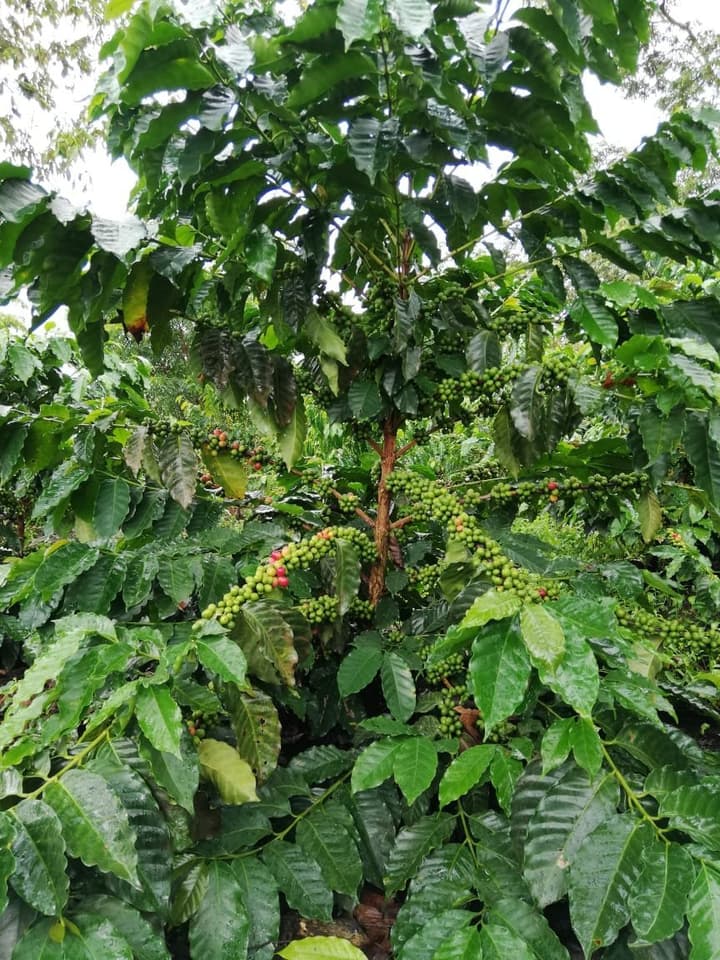F1 Hybrids Explainer
Redefining what’s possible for coffee producers.
While F1 hybrid varieties are still relatively new to coffee farmers and industry, it is difficult to imagine a future without them. No varieties in the past have been able to combine traits that matter to both farmers and consumers in quite the same way. F1 hybrids will be key to helping coffee producers remain profitable and resilient in the face of climate change. But there are also critical tradeoffs, including the fact that they are more expensive to produce, and that they are risky for farmers who are used to saving their own seed (F1 plants should always be obtained from quality nurseries).
F1 hybrid FAQs
Is F1 a variety?
It’s a class or type of varieties made by crossing two genetically distant parents and using the first generation (F1) progeny. There are many F1 hybrid crosses being tested right now, some of which will be released for farmers in the coming years.

An F1 hybrid from WCR's research farm in El Salvador.
What makes F1 hybrids outperform other varieties?
An F1 hybrid contains a complete mix of the genetics of both parents. This higher genetic potential means it is more likely to be adaptable across a wide range of environments. F1 hybrids are known to have a higher level of adaptability and performance due to “hybrid vigor”—they produce more cherry than either of the parents would and are more tolerant of diseases and pests than each parent would be alone. F1s eliminate many of the tradeoffs of the past—for example, coffee leaf rust resistance versus quality. F1s can be immune to rust and still score over 90 points in cupping evaluations.
Are there drawbacks?
The main drawback of F1 hybrids is that they are more expensive and harder to mass produce—typically they need to be purchased from experienced nurseries.
If you try to save and use the seed of a good F1 plant on your farm (which would be the F2, or second generation originating from the initial cross), all the various combinations of the dominant and recessive traits from the two parent plants will be expressed in the F2 generation. So the farmer will get a bunch of baby plants that are extremely diverse—some taller, some shorter, some strong, some weak. But guaranteed, very few will look and behave like the really amazing F1 she has growing in her field. The only way to ensure that you have the great performance is to have the first generation offspring of the cross (e.g., the F1) itself, and the main way to mass produce them today is to produce clones in labs. World Coffee Research and others are conducting research to work toward enabling the mass production of F1s from seed.
Are F1 hybrids worth the higher cost?
Ultimately, the choice about costs versus benefits belongs to the farmer. But in general, F1 hybrids have substantially improved performance over traditional varieties, and do justify the higher cost for farmers who can afford them. For example, an F1 hybrid might cost $.75 versus a traditional seedling that cost $.25. For the added $.50, the F1 hybrid plant will have its first harvest two years after planting instead of three (an entire year of income generation added), plus increased yield of up to 50% every year that the plant is in production (depending on the specific variety and the management practices of the farm). The farmer will face fewer losses due to disease, and will maintain the ability for high cup-quality scores if they are in a suitable environment to produce it. In 2018, nine of the top 20 coffees in the Nicaragua Cup of Excellence competition were F1 hybrids.
Are there any F1 hybrids available to farmers right now?
Although WCR's own F1 hybrids are not yet available to farmers, there are some F1 hybrids that are available in some parts of the world. Some of the available F1s are: Centroamericano (also called H1 sometimes), Casiopea, Milenio, Mundo Maya, Starmaya, Ruiru 11. In 2018, multiple of these varieties scored in the top 10 in Cup of Excellence competitions around the world. For more information on these varieties, visit varieties.worldcoffeeresearch.org
Are F1 hybrids genetically modified?
No. World Coffee Research has a policy against genetic modification. Crosses are made using traditional methods—literally painting pollen from the flower of one tree onto the flower of another. But we use advanced genetics to determine which parents to cross.
How are F1 hybrids created?
Generally in plant breeding, the greater the genetic distance between the two parents of hybrid offspring, the more “vigorous” the child will be. In coffee, heterosis frequently translates to productivity, uniformity, and better vegetative growth.
WCR is enabling accelerated creation of F1 hybrids around the world by producing the tools that breeders need to determine the optimal genetic distance between two potential hybrid parents. In 2016, WCR completed an exhaustive study of the genetic diversity of 826 Arabica plants that allowed us to do two key things. First, we were able to identify the 100 most genetically diverse Arabicas, called the Core Collection, which are now being grown as an essential new reservoir of genetic diversity for coffee breeders. The study also allowed us to determine how genetically different the plants are from one another. This “genetic distance matrix” is an essential tool to exploit hybrid vigor.
Using the genetic distance matrix, we can take existing high-performing varieties known for desired traits like quality (e.g., Geisha) or disease resistance (e.g., Obata), and locate mates that are genetically distant to maximize hybrid vigor—yield—in the offspring.
